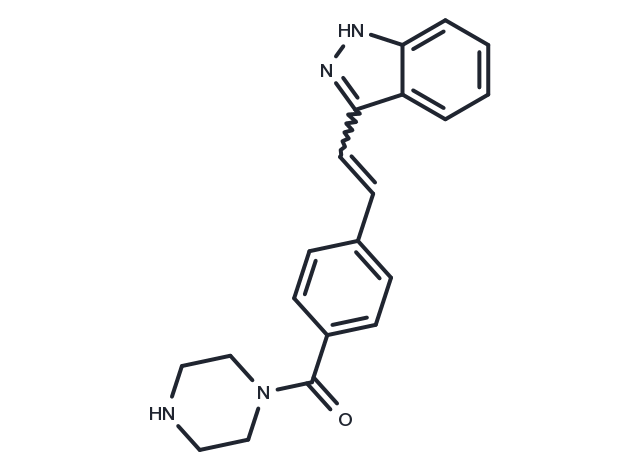Powder: -20°C for 3 years | In solvent: -80°C for 1 year


KW-2449 is a multiple-targeted inhibitor, mostly for Flt3 (IC50: 6.6 nM), modestly effective to Bcr-Abl, FGFR1, and Aurora A; little inhibitory on PDGFRβ, IGF-1R, EGFR.

| Pack Size | Availability | Price/USD | Quantity |
|---|---|---|---|
| 2 mg | In stock | $ 33.00 | |
| 5 mg | In stock | $ 52.00 | |
| 10 mg | In stock | $ 72.00 | |
| 25 mg | In stock | $ 148.00 | |
| 50 mg | In stock | $ 273.00 | |
| 100 mg | In stock | $ 508.00 | |
| 500 mg | In stock | $ 1,130.00 | |
| 1 mL * 10 mM (in DMSO) | In stock | $ 54.00 |




| Description | KW-2449 is a multiple-targeted inhibitor, mostly for Flt3 (IC50: 6.6 nM), modestly effective to Bcr-Abl, FGFR1, and Aurora A; little inhibitory on PDGFRβ, IGF-1R, EGFR. |
| Targets&IC50 | FLT3:6.6 nM |
| In vitro | In the MOLM-13 xenograft model, KW-2449 administered orally for 14 days (p.o., 14 days) demonstrates a significant anticancer effect, which exhibits dose-dependency. |
| In vivo | In patients with leukemia harboring FLT3 mutations and resistant to Imatinib, KW-2449 exhibits significant activity and has been granted clinical study authorization. KW-2449 reduces the phosphorylation of FLT3 and STAT5 in a dose-dependent manner and shows potent inhibition against ABL-T315I (IC50: 4 nM) without affecting PDGFRβ, IGF-1R, EGFR, and several serine/threonine kinases at 1 μM. It significantly inhibits the growth of leukemia cells expressing FLT3/ITD, cells with FLT3/KDM activation, and those overexpressing wild-type FLT3. In MOLM-13 cells, KW-2449 dose-dependently inhibits the phosphorylation of FLT3 and the downstream molecule phospho-STAT5, increases the percentage of cells in the G1 phase, decreases the S phase percentage, leading to an increase in apoptotic cell numbers. KW-2449 promotes dephosphorylation of constitutionally active WT-FLT3 kinase without affecting leukemia cell proliferation. It is rapidly absorbed and converted into a major metabolite M1. |
| Kinase Assay | FLT3 phosphorylation: Leukemia cells are washed in phosphate-buffered saline (PBS), then lysed by resuspending the cells in lysis buffer (20 mM Tris pH 7.4, 100 mM NaCl, 1% Igepal, 1 mM EDTA, 2 mM NaVO4, plus Complete protease inhibitor KW-2449 for 30 minutes while rocking. The extract is clarified by centrifugation at 1.6 × 104?g and the supernatant is assayed for protein (Bio-Rad). A 50-μg aliquot is removed as a whole-cell lysate for analysis of STAT5, and the remainder is used for immunoprecipitation with anti-FLT3. Anti-FLT3 antibody is added to the extract for overnight incubation, then protein A sepharose is added for 2 additional hours. Separate sodium dodecyl sulfate–polyacrylamide electrophoresis (SDS-PAGE) gels for whole-cell lysate and immunoprecipates are run in parallel. After transfer to Immobilon membranes, immunoblotting is performed with antiphosphotyrosine antibody (4 g10) to detect phosphorylated FLT3 or, for the whole-cell lysate gels, with a rat monoclonal antibody against phosphorylated STAT5 (residue Y694) then stripped and reprobed with anti-FLT3 antibody to measure total FLT3. Proteins are visualized using chemiluminescence, exposed on Kodak BioMax XAR film, developed, and scanned using a Bio-Rad GS800 densitometer. The concentration of KW-2449 for which the phosphorylation of FLT3 or STAT5 is inhibited to 50% of its baseline (IC50) is determined using linear regression analysis of the dose response curves. For direct analysis of FLT3 and STAT5 in circulating blasts, peripheral blood is collected in heparinized tubes and promptly chilled on ice. Samples are centrifuged for 10 minutes at 900 g, at 4 °C. The plasma is removed and stored frozen at ?80 °C. The buffy coat is carefully transferred to ice-cold PBS, layered onto chilled Ficoll-Hypaque, and centrifuged for 5 minutes at 600 g, at 4 °C. All subsequent steps are carried out at 4 °C. Mononuclear cells are collected and washed rapidly once in red blood cell lysis buffer (0.155 M NH4Cl, 0.01 M KHCO3, 0.1 mM EDTA), then washed once in PBS. Cells are then lysed as described for FLT3 and STAT5 analysis. |
| Cell Research | Cell viability is determined by the sodium 3′-[1-(phenylaminocarbonyl)-3, 4-tetrazolium]-bis (4-methoxy-6-nitro) benzene sulfonic acid hydrate assay after incubation with or without KW-2449 for 72 hours at 37 °C. The number of viable cells is determined using the Cell Proliferation Kit II. For cell-cycle analysis, MOLM-13 and RS4;11 cells are treated with KW-2449. After 24, 48, and 72 hours of incubation at 37 °C, DNA contents are analyzed. Cell cycle distribution of K562, TCC-Y, and TCC/Ysr is analyzed 24 hours after treatment with KW-2449 or imatinib. (Only for Reference) |
| Synonyms | KW2449 |
| Molecular Weight | 332.4 |
| Formula | C20H20N4O |
| CAS No. | 1000669-72-6 |
Powder: -20°C for 3 years | In solvent: -80°C for 1 year
DMSO: 62 mg/mL (186.5 mM)
H2O: < 1 mg/mL (insoluble or slightly soluble)
Ethanol: 62 mg/mL (186.5 mM)
You can also refer to dose conversion for different animals. More
bottom
Please see Inhibitor Handling Instructions for more frequently ask questions. Topics include: how to prepare stock solutions, how to store products, and cautions on cell-based assays & animal experiments, etc.
KW-2449 1000669-72-6 Angiogenesis Apoptosis Cell Cycle/Checkpoint Chromatin/Epigenetic Cytoskeletal Signaling JAK/STAT signaling Stem Cells Tyrosine Kinase/Adaptors JAK Bcr-Abl Src c-Kit Aurora Kinase FLT FGFR Cluster of differentiation antigen 135 Fibroblast growth factor receptor inhibit Fms like tyrosine kinase 3 Inhibitor KW2449 KW 2449 FLT3 CD135 inhibitor
